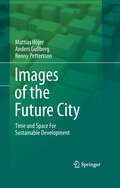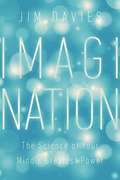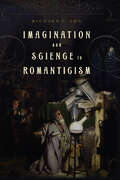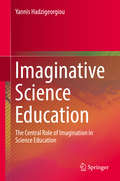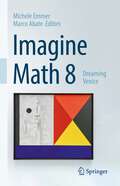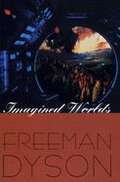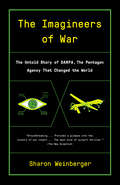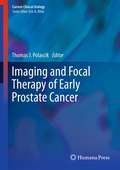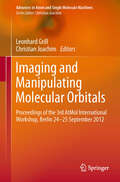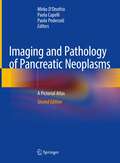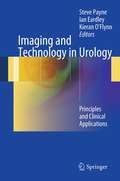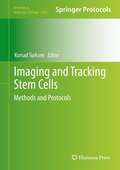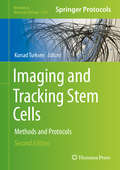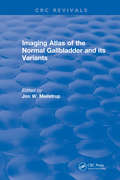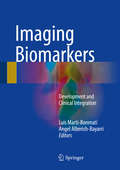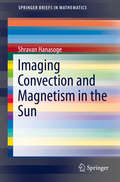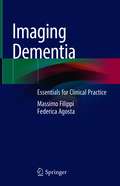- Table View
- List View
Images of the Future City: Time and Space For Sustainable Development
by Ronny Pettersson Mattias Höjer Anders GullbergThis book is an ideal complement to studies showing the potentially devastating ecological effects of climate change, studies trying to calculate the costs of climate change, and studies trying to identify the most pressing needs in preparing for the new climate.
Imagination: Understanding Our Mind's Greatest Power
by Jim DaviesThe first-ever book on the science of imagination, which sheds light on both the complex inner-workings of our mind and the ways in which we can channel imagination for a better life. We don’t think of imagination the way that we should. The word is often only associated with children, artists and daydreamers, viewed as something separate from everyday adult life. However, imagination is an integral part of almost every action and decision that we make. Simply put, imagination is a person’s ability to create scenarios in his or her head: this can include everything from planning a grocery list, to honing a golf swing, and even to having religious hallucinations. And while imagination has positive connotations, it can also lead to more pernicious outcomes including decreased productivity and cooperation, and much worse, the continuous reliving of past trauma. The human brain is remarkable in its ability to imagine—to create worlds and situations outside of its reality. We can imagine complex possible futures, fantasy worlds, and jars of peanut butter. We can use our imaginations to make us relaxed or anxious, and the most impressive feat of human imagination may be our ability to use it in creative endeavors. Sitting in a chair, with our eyes closed, we can imagine what the world might be, and construct elaborate plans. With such power, we have an obligation to use it for good—to make things better for ourselves, and for the world. People have been fascinated with the machination of the human brain and its ability to imagine for centuries, but until now, there have been no popular science books that are dedicated to imagination. There are books on creativity, dreams, memory, and the mind in general, but how exactly do we create those scenes in our head? With chapters ranging from hallucination and imaginary friends to how imagination can make you happier and more productive, Jim Davies' Imagination will help us explore the full potential of our own mind.
Imagination and Science in Romanticism
by Richard C. ShaHow did the idea of the imagination impact Romantic literature and science?2018 Winner, Jean-Pierre Barricelli Book Prize, The International Conference on RomanticismRichard C. Sha argues that scientific understandings of the imagination indelibly shaped literary Romanticism. Challenging the idea that the imagination found a home only on the side of the literary, as a mental vehicle for transcending the worldly materials of the sciences, Sha shows how imagination helped to operationalize both scientific and literary discovery. Essentially, the imagination forced writers to consider the difference between what was possible and impossible while thinking about how that difference could be known. Sha examines how the imagination functioned within physics and chemistry in Percy Bysshe Shelley's Prometheus Unbound, neurology in Blake's Vala, or The Four Zoas, physiology in Coleridge's Biographia Literaria, and obstetrics and embryology in Mary Shelley's Frankenstein. He also demonstrates how the imagination was called upon to do aesthetic and scientific work using primary examples taken from the work of scientists and philosophers Davy, Dalton, Faraday, Priestley, Kant, Mary Somerville, Oersted, Marcet, Smellie, Swedenborg, Blumenbach, Buffon, Erasmus Darwin, and Von Baer, among others. Sha concludes that both fields benefited from thinking about how imagination could cooperate with reason—but that this partnership was impossible unless imagination's penchant for fantasy could be contained.
The Imagination of Experiences: Musical Invention, Collaboration, and the Making of Meanings
by Alan TaylorAimed at lay, student, and academic readers alike, this book concerns the imagination and, specifically, imagination in music. It opens with a discussion of the invalidity of the idea of the creative genius and the connected view that ideas originate just in the individual mind. An alternative view of the imaginative process is then presented, that ideas spring from a subconscious dialogue activated by engagement in the world around. Ideas are therefore never just of our own making. This view is supported by evidence from many studies and corresponds with descriptions by artists of their experience of imagining. The third subject is how imaginations can be shared when musicians work with other artists, and the way the constraints imposed by trying to share subconscious imagining result in clearly distinct forms of joint working. The final chapter covers the use of the musical imagination in making meanings from music. The evidence is that music does not communicate meanings directly, and so composers or performers cannot be looked to as authorities on its meaning. Instead, music is commonly heard as analogous to human experience, and listeners who perceive such analogies may then imagine their own meanings from the music.
Imagination of Science in Education
by Michiel Van Eijck Wolff-Michael RothResearchers agree that schools construct a particular image of science, in which some characteristics are featured while others end up in oblivion. The result is that although most children are likely to be familiar with images of heroic scientists such as Einstein and Darwin, they rarely learn about the messy, day-to-day practice of science in which scientists are ordinary humans. Surprisingly, the process by which this imagination of science in education occurs has rarely been theorized. This is all the more remarkable since great thinkers tend to agree that the formation of images -- imagination -- is at the root of how human beings modify their material world. Hence this process in school science is fundamental to the way in which scientists, being the successful agents in/of science education, actually create their own scientific enterprise once they take up their professional life. One of the first to examine the topic, this book takes a theoretical approach to understanding the process of imagining science in education. The authors utilize a number of interpretive studies in both science and science education to describe and contrast two opposing forces in the imagination of science in education: epicization and novelization. Currently, they argue, the imagination of science in education is dominated by epicization, which provides an absolute past of scientific heroes and peak discoveries. This opens a distance between students and today's scientific enterprises, and contrasts sharply with the wider aim of science education to bring the actual world of science closer to students. To better understand how to reach this aim, the authors offer a detailed look at novelization, which is a continuous renewal of narratives that derives from dialogical interaction. The book brings together two hitherto separate fields of research in science education: psychologically informed research on students' images of science and semiotically informed research on images of science in textbooks. Drawing on a series of studies in which children participate in the imagination of science in and out of the classroom, the authors show how the process of novelization actually occurs in the practice of education and outline the various images of science this process ultimately yields.
Imaginative Science Education
by Yannis HadzigeorgiouThisbook is about imaginative approaches to teaching and learning school science. Its central premise is that science learning should reflect the nature ofscience, and therefore be approached as an imaginative/creative activity. As such, the book can be seen as an originalcontribution of ideas relating to imagination and creativity in scienceeducation. Theapproaches discussed in the book are storytelling, the experience of wonder,the development of 'romantic understanding', and creative science, includingscience through visual art, poetry and dramatization. However, given theperennial problem of how to engage students (of all ages) in science, thenotion of 'aesthetic experience', and hence the possibility for students tohave more holistic and fulfilling learning experiences through theaforementioned imaginative approaches, is also discussed. Eachchapter provides an in-depth discussion of the theoretical background of aspecific imaginative approach (e. g. , storytelling, 'wonder-full' science),reviews the existing empirical evidence regarding its role in the learningprocess, and points out its implications for pedagogy and instructional practices. Examples from physical science illustrating its implementation in the classroomare also discussed. Indistinguishing between 'participation in a science activity' and 'engagementwith science ideas per se', the book emphasizes the central role of imaginativeengagement with science content knowledge, and thus the potential of therecommended imaginative approaches to attract students to the world ofscience.
Imagine Math 8: Dreaming Venice
by Michele Emmer Marco AbateThis eighth volume of Imagine Math is different from all the previous ones. The reason is very clear: in the last two years, the world changed, and we still do not know what the world of tomorrow will look like. Difficult to make predictions. This volume has a subtitle Dreaming Venice. Venice, the dream city of dreams, that miraculous image of a city on water that resisted for hundreds of years, has become in the last two years truly unreachable. Many things tie this book to the previous ones. Once again, this volume also starts like Imagine Math 7, with a homage to the Italian artist Mimmo Paladino who created exclusively for the Imagine Math 8 volume a new series of ten original and unique works of art dedicated to Piero della Francesca. Many artists, art historians, designers and musicians are involved in the new book, including Linda D. Henderson and Marco Pierini, Claudio Ambrosini and Davide Amodio. Space also for comics and mathematics in a Disney key. Many applications, from Origami to mathematical models for world hunger. Particular attention to classical and modern architecture, with Tullia Iori.As usual, the topics are treated in a way that is rigorous but captivating, detailed and full of evocations. This is an all-embracing look at the world of mathematics and culture.
Imagined Life: A Speculative Scientific Journey among the Exoplanets in Search of Intelligent Aliens, Ice Creatures, and Supergravity Animals
by James Trefil Michael SummersThe captivating possibilities of extraterrestrial life on exoplanets, based on current scientific knowledge of existing worlds and forms of lifeIt is now known that we live in a galaxy with more planets than stars. The Milky Way alone encompasses 30 trillion potential home planets. Scientists Trefil and Summers bring readers on a marvelous experimental voyage through the possibilities of life--unlike anything we have experienced so far--that could exist on planets outside our own solar system.Life could be out there in many forms: on frozen worlds, living in liquid oceans beneath ice and communicating (and even battling) with bubbles; on super-dense planets, where they would have evolved body types capable of dealing with extreme gravity; on tidally locked planets with one side turned eternally toward a star; and even on "rogue worlds," which have no star at all. Yet this is no fictional flight of fancy: the authors take what we know about exoplanets and life on our own world and use that data to hypothesize about how, where, and which sorts of life might develop. Imagined Life is a must-have for anyone wanting to learn how the realities of our universe may turn out to be far stranger than fiction.
Imagined Worlds (Jerusalem-Harvard Lectures)
by Freeman DysonImagine a world where whole eons will pass, cultures rise and fall, between a telephone call and its reply. Think of the human race multiplying 500-millionfold or evolving new, unique species. Consider the technology of space colonization, computer-assisted reproduction, the "Martian potato." One hundred years after H. G. Wells visited the future in "The Time Machine," Freeman Dyson marshals his uncommon gifts as a scientist and storyteller to take us once more to such worlds, which may or may not be in our future.
The Imagineers of War: The Untold Story of DARPA, the Pentagon Agency That Changed the World
by Sharon WeinbergerThe definitive history of the Defense Advanced Research Projects Agency, the Pentagon agency that has quietly shaped war and technology for nearly sixty years.Founded in 1958 in response to the launch of Sputnik, the agency’s original mission was to create “the unimagined weapons of the future.” Over the decades, DARPA has been responsible for countless inventions and technologies that extend well beyond military technology. Sharon Weinberger gives us a riveting account of DARPA’s successes and failures, its remarkable innovations, and its wild-eyed schemes. We see how the threat of nuclear Armageddon sparked investment in computer networking, leading to the Internet, as well as to a proposal to power a missile-destroying particle beam by draining the Great Lakes. We learn how DARPA was responsible during the Vietnam War for both Agent Orange and the development of the world’s first armed drones, and how after 9/11 the agency sparked a national controversy over surveillance with its data-mining research. And we see how DARPA’s success with self-driving cars was followed by disappointing contributions to the Afghanistan and Iraq wars.Weinberger has interviewed more than one hundred former Pentagon officials and scientists involved in DARPA’s projects—many of whom have never spoken publicly about their work with the agency—and pored over countless declassified records from archives around the country, documents obtained under the Freedom of Information Act, and exclusive materials provided by sources. The Imagineers of War is a compelling and groundbreaking history in which science, technology, and politics collide.
Imaging and Focal Therapy of Early Prostate Cancer
by Thomas J. PolascikImaging and Focal Therapy of Early Prostate Cancer evaluates the scientific evidence for the evolving trend to treat low to intermediate risk, clinically localized prostate cancer in a focally ablative manner with novel gland-preserving, focal therapy methods. Various ablative devices such as high intensity focused ultrasound, irreversible electroporation, photodynamic therapy, cryotherapy and laser ablation, among others, are discussed in regard to their strengths and limitations as a therapeutic modality. Emphasis is placed on tumor stage shift towards early stage disease with an increase in unilateral versus bilateral cancers validated by final pathology assessment of large prostatectomy series. Current and new approaches to image cancer foci within the prostate (3-Dimensional contrast-enhanced transrectal ultrasonography, multiparametric magnetic resonance image with spectroscopy, ETC) are presented along with biopsy techniques to map prostate cancer. Patient selection, treatment strategy, outcomes and safety concerns that may provide acceptable cancer control and improved quality of life for patients are all covered in detail. Written by experts in the field and lavishly illustrated with detailed line-art and photographs, Imaging and Focal Therapy of Early Prostate Cancer is a resourceful volume beneficial to practitioners specializing in the treatment and management of prostate cancer.
Imaging and Manipulating Molecular Orbitals: Proceedings of the 3rd AtMol International Workshop, Berlin 24-25 September 2012
by Christian Joachim Leonard GrillImaging and Manipulating Molecular Orbitals celebrates the 60th anniversary of the first image of a single molecule by E. Müller. This book summarizes the advances in the field from various groups around the world who use a broad range of experimental techniques: scanning probe microscopy (STM and AFM), field emission microscopy, transmission electron microscopy, attosecond tomography and photoemission spectroscopy. The book is aimed at those who are interested in the field of molecular orbital imaging and manipulation. Included in the book are a variety of experimental techniques in combination with theoretical approaches which describe the spatial distribution and energies of the molecular orbitals. The goal is to provide the reader with an up-to-date summary on the latest developments in this field from various points of view.
Imaging and Manipulation of Adsorbates Using Dynamic Force Microscopy
by Philip Moriarty Sebastién GauthierImaging and Manipulation of Adsorbates using Dynamic Force Microscopy provides an overview of the latest developments in dynamic force microscopy (DFM) of atoms, molecules, and nanoparticles adsorbed on solid surfaces. Significant advances in the capabilities of this technique have been made in the last decade and this book represents a timely snapshot of the major research themes in the field, with a particular focus on the manipulation of matter at the atomic and (sub)molecular levels. This edited volume will be of keen interest to researchers active in nanoscience and its various sub-fields including, in particular, scanning probe microscopy. This book expands on the previous volumes in the series Advances in Atom and Single Molecule Machines. DFM is an exceptionally powerful tool for the imaging and probing of adsorbates on insulators and is now a component of the type of multiprobe interconnection systems described in Vol. 1 of the series. DFM can also be used to translate atoms and molecules in the context of the fabrication of the type of logic gates described in Vol. 2. When used in conjunction with STM, DFM also enables a detailed comparison of the chemical 'architecture' of a molecule with the spatial distribution of its orbital density, as described in Vol. 3. In this book readers will gain key insights into the current capabilities, and future potential, of dynamic force microscopy.
Imaging and Pathology of Pancreatic Neoplasms: A Pictorial Atlas
by Mirko D’Onofrio Paola Capelli Paolo PederzoliThe second edition of this atlas focuses on imaging methods and techniques, new diagnostic concepts and therapeutic approaches in management of pancreatic neoplasms. Although interest in pancreatic pathology is very high in the radiological and gastroenterological communities, less is known about it than about, for example, liver pathology. Diagnosis depends on the structure of the pancreatic lesion, which can be directly visualized in US, CT or MR images.The book’s focus is very much on the imaging and pathological appearances, with most of the text concentrated at the beginning of the book followed by images gallery. A comprehensive overview is provided of typical and atypical presentations and diverse aspects of common and rare pancreatic tumors, including ductal adenocarcinomas with dedicated chapter to ductal adenocarcinoma downstaging, neuroendocrine neoplasms, cystic pancreatic neoplasms and intraductal papillary mucinous neoplasms. The Verona “Pancreas Centre,” the first institute of its kind in Italy and one of very few in the world, pursues an interdisciplinary approach to treating the problems of this organ, focusing on the patient, on research, and on teaching. A dedicated center that can look back on 40 years of tradition, many of its respected specialists have made essential contributions in surgery, gastroenterology, oncology, pathology, and radiology. Given its scope, this atlas will be an invaluable asset, helping radiologists understand the underlying pathology and helping pancreatic pathologists understand the imaging translation.
Imaging and Technology in Urology
by Steve Payne Kieran O'Flynn Ian EardleyImaging and Technology: Principles and Clinical Applications is a practical and user-friendly consolidated source book for urologists, and urologists in training, regarding the basic science of imaging modalities used on a day-to-day basis in urological practice. Similarly, the intention is to provide an introduction to the technology that is used in the practice of urological surgery and the management of urological patients in the clinical setting. This knowledge level is appropriate for certification for independent consultant practice in urology in the UK. The book is also valuable to urologists and urological trainees outside of the UK and in other surgical specialities.
Imaging and Technology in Urology
by Steve Payne Sotonye Tolofari Dora Moon Benjamin StarmerThis book offers a new edition of the hugely successful title, Imaging & Technology in Urology--Principles and Clinical Applications edited by Steve Payne, Ian Eardley, Kieran O'Flynn in 2012. Essential reading for preparation of exit exams in Urology, it is used worldwide by exam candidates. Fully updated in essential areas of the book following on from recent developments in the last decade, it helps give preparation to candidates. The most comprehensive and reliable source of information on this particular topic.
Imaging and Tracking Stem Cells: Methods and Protocols
by Kursad TurksenImaging and Tracking Stem Cells: Methods and Protocols gathers representative protocols related to the vital techniques of stem cell imaging and lineage tracing, including that of live cells, both in vivo and in vitro. The detailed chapters presented within have been validated for reproducibility and are described in an easy to follow, step-by-step fashion so as to be valuable for not only experts but also novices in the stem cell field. As with other volumes in the highly successful Methods in Molecular Biology series, chapters conclude with a Notes section, which provides tips on troubleshooting and avoiding known pitfalls. Authoritative and practical, Imaging and Tracking Stem Cells: Methods and Protocols provides both a flavor of the field as it currently is and a source to stimulate new approaches and methodologies by those interested in tracking stem cells and their progeny.
Imaging and Tracking Stem Cells: Methods and Protocols (Methods in Molecular Biology #2150)
by Kursad TurksenThis fully updated book brings together protocols to arm stem cell biologists with tools and approaches to continue uncovering the intricacies and regulatory mechanisms underlying stem cell biology. Through various models and organ systems, the volume reflects the numerous recent advances in cell lineage and lineage tracking. Written for the highly successful Methods in Molecular Biology series, chapters include introductions to their respective topics, lists of the necessary materials and reagents, step-by-step, readily reproducible laboratory protocols, and tips on troubleshooting and avoiding known pitfalls. Authoritative and up-to-date, Imaging and Tracking Stem Cells: Methods and Protocols, Second Edition is an ideal guide for novices and experts alike who are working to expand our knowledge in the field of stem cells.
Imaging and Urodynamics of the Lower Urinary Tract
by Uday PatelThis book is a practical text covering the imaging techniques and the range of urodynamic problems the trainee and practising urologist is likely to encounter including; congenital abnormalities of the bladder, functional abnormalities of the bladder, intraluminal abnormalities and staging of bladder cancer. The urethra and lower urinary tract are also dealt with. Although these disorders are covered in the major reference works, there is a need for a practical, accessible, user friendly text which provides clear and unambiguous guidelines on the best practice available.
Imaging Atlas of Ophthalmic Tumors and Diseases
by J. Matthew DebnamThis atlas describes an array of tumors and diseases that affect the orbit and associated cranial nerves. Often lacking in radiology residency and fellowship training is teaching of the anatomy of the orbit and cranial nerves, as well as the imaging appearance of orbital tumors and diseases that affect these regions. This atlas fills this gap of knowledge with tumors and diseases encountered and treated at MD Anderson Cancer Center, providing a review of the imaging anatomy and the appearance of the tumors and diseases that should aid in formatting a differential diagnosis. The text consists of ten chapters divided into separate anatomic sections followed by an eleventh chapter describing the treated orbit and tumor recurrence. Each of the first ten chapters begins with a description of the relevant anatomy, labeled CT and MRI images and drawings to highlight important anatomic considerations. This is an ideal guide for practicing general radiologists, neuroradiologists and trainees, as well as ophthalmologists, head and neck surgeons, neurosurgeons, medical and radiation oncologists, and pathologists who interpret or review orbital images as part of their daily practice.
Imaging Atlas of the Normal Gallbladder and Its Variants
by J.W. MeilstrupAn in-depth knowledge of the wide spectrum of normal gallbladder appearances is vital to appropriate clinical workup and the correct diagnosis of patients with upper abdominal symptoms. This book covers the range of appearances of the normal gallbladder and its variants, including discussions of anatomy, embryology, and imaging techniques to promote a better understanding of the subject. Anomalies of number, location, and form are each addressed in separate chapters, and discussions of imaging artifacts of the gallbladder and pseudolesions, which can mimic gallbladder disease, are also included. A short chapter on the appearance of the fetal gallbladder is included to round out this comprehensive volume.
Imaging Biomarkers
by Luis Martí-Bonmatí Angel Alberich-BayarriThis is the first book to cover all aspects of the development of imaging biomarkers and their integration into clinical practice, from the conceptual basis through to the technical aspects that need to be considered in order to ensure that medical imaging can serve as a powerful quantification instrument capable of providing valuable information on organ and tissue properties. The process of imaging biomarker development is considered step by step, covering proof of concept, proof of mechanism, image acquisition, image preparation, imaging biomarker analysis and measurement, detection of measurement biases (proof of principle), proof of efficacy and effectiveness, and reporting of results. Sources of uncertainty in the accuracy and precision of measurements and pearls and pitfalls in gold standards and biological correlation are discussed. In addition, practical use cases are included on imaging biomarker implementation in brain, oncologic, cardiovascular, musculoskeletal, and abdominal diseases. The authors are a multidisciplinary team of expert radiologists and engineers, and the book will be of value to all with an interest in the quantitative imaging of biomarkers in personalized medicine.
Imaging Cell Signaling (Methods in Molecular Biology #2800)
by Robert F. Murphy Christoph WülfingThis volume explores recent innovations across the entire pipeline of imaging signal transduction, cell preparation, cellular manipulation, image acquisition, and computational analysis. The chapters in this book cover topics such as rapid preparation of living Drosophila pupal macrophages for ex vivo imaging; controlling the potency of T cell activation using an optically tuneable chimeric antigen receptor; in situ imaging of proteins using DNA-PAINT super-resolution microscopy; reconstructing signaling networks using biosensor barcoding; and morphological, spatial, and dynamic models for cellular components. Written in the highly successful Methods in Molecular Biology series format, chapters include introductions to their respective topics, lists of the necessary materials and reagents, step-by-step, readily reproducible laboratory protocols, and tips on troubleshooting and avoiding known pitfalls.Cutting-edge and authoritative, Imaging Cell Signaling is a valuable resource that provides guidance to researchers looking to learn how to effectively tailor design projects to image, manipulate, and model signal transduction.
Imaging Convection and Magnetism in the Sun
by Shravan HanasogeThis book reviews the field of helioseismology and its outstanding challenges and also offers a detailed discussion of the latest computational methodologies. The focus is on the development and implementation of techniques to create 3-D images of convection and magnetism in the solar interior and to introduce the latest computational and theoretical methods to the interested reader. With the increasing availability of computational resources, demand for greater accuracy in the interpretation of helioseismic measurements and the advent of billion-dollar instruments taking high-quality observations, computational methods of helioseismology that enable probing the 3-D structure of the Sun have increasingly become central. This book will benefit students and researchers with proficiency in basic numerical methods, differential equations and linear algebra who are interested in helioseismology.
Imaging Dementia: Essentials for Clinical Practice
by Massimo Filippi Federica AgostaThis book helps physicians select from among the currently available imaging tools, promoting the correct and cost-saving diagnosis and management of common dementias. Magnetic resonance (MR) and nuclear medicine techniques are routinely used to facilitate diagnosis, select therapies, provide information regarding the prognosis, and monitor therapy response in patients with cognitive impairment and dementia. Furthermore, the advent of quantitative MR techniques, such as diffusion-weighted imaging, perfusion imaging, etc. have opened up new opportunities to diagnose neurological diseases based on objective findings, and offer unique new insights into the main neurodegenerative diseases of the human brain. However, the practical value of various neuroimaging techniques in clinical practice has yet to be clearly defined, and their potential for future development is not yet fully appreciated.To help remedy the situation, this book offers practical and useful algorithms and rules that can be directly applied in the clinical setting. It provides concise content, together with a wealth of clinical case material.
